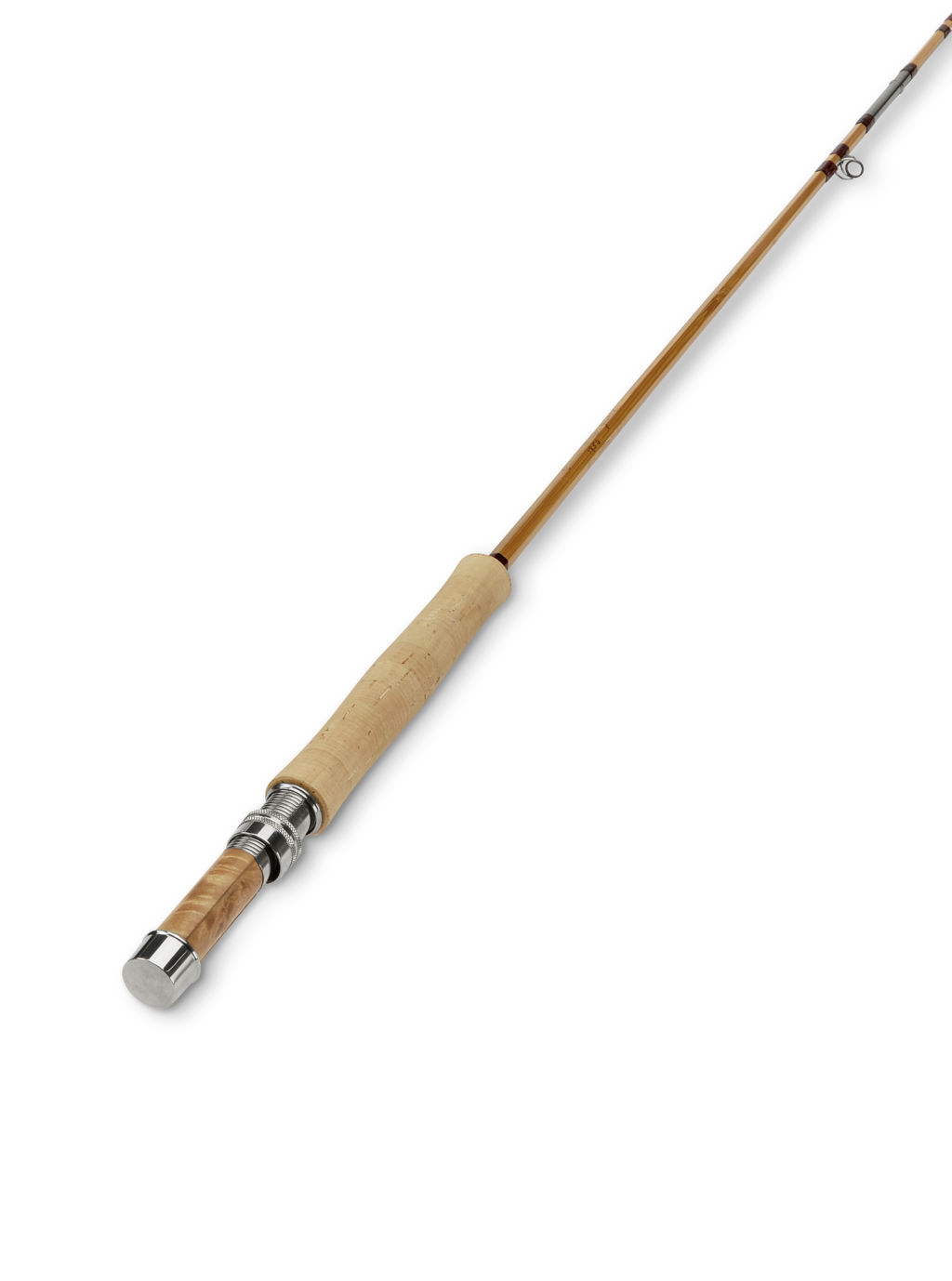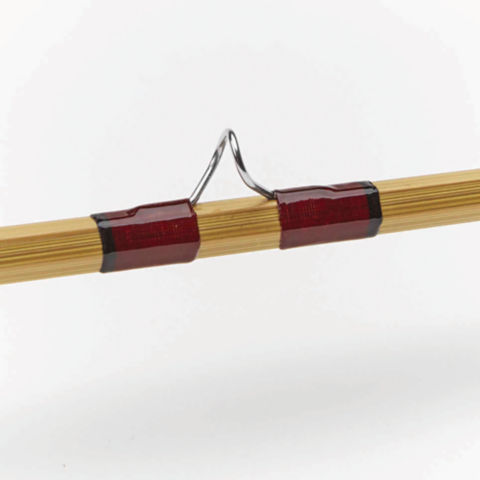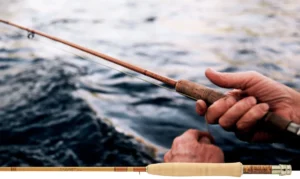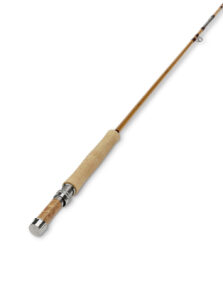
The Orvis 1856 Bamboo Fly Rod: A Timeless Companion for Trout and Bass
Imagine standing arse-deep in a cold, western, free stone river, the sun flashing through the trees, and a gentle breeze ruffling the water’s surface. You make a cast and watch as the line unfurls gracefully, the bamboo rod in your hand flexing with life. This is the quintessence of fishing with the Orvis 1856 Bamboo Fly Rod, a piece of angling art that connects you to the sport’s storied past while delivering the performance demanded by modern fishermen.
Article-at-a-Glance: Overview of the Orvis 1856 Bamboo Fly Rod
-
Classic feel with a touch of modern versatility.
-
Designed for precision casting on larger water bodies.
-
Expert craftsmanship from a company with a rich fishing heritage.
-
Perfect for targeting both trout and bass along with other species.
-
Support and resources available for maintenance and care.
Heirloom Quality with Modern Performance
The Orvis 1856 isn’t just a fly rod; it’s a bridge between the time-honored tradition of bamboo rod crafting and the peak of contemporary fishing technology. This rod is for those who revere the history of fly fishing but demand the precision and performance that modern waters and fish require. It’s a testament to the idea that some things get better with age, especially when they’re built on a foundation of quality and innovation.
The Craftsmanship Behind the Orvis 1856
Each Orvis 1856 Bamboo Fly Rod is a labor of love, shaped by the hands of master craftsmen. The process begins with selecting the finest Tonkin bamboo, a material known for its strength, flexibility, and beauty. The bamboo is then split, tapered, and heat-treated to create a rod that’s both resilient and responsive. It’s a meticulous process that ensures every 1856 model isn’t just a tool for fishing but a work of art that stands the test of time. A fly fishing legacy heirloom to be passed down from parent to child and grandchild.
“In a world where we’re often surrounded by the disposable, there’s something profoundly satisfying about owning a piece of gear that could last a lifetime. The Orvis 1856 is exactly that—a rod that becomes more than just a rod; it becomes a trusted companion on every fishing adventure.” – An Orvis 1856 Bamboo Fly Rod Enthusiast
Why Bamboo? Unpacking the Appeal for Anglers
For those new to the world of fly fishing, the allure of bamboo may not be immediately apparent. After all, modern graphite rods are lighter and often more powerful. But bamboo rods, like the Orvis 1856, offer a unique set of characteristics that many anglers find irresistible. They have a natural flex that can’t be replicated, providing a smooth casting experience and a sensitivity that connects you to the water and fish in a way no other material can. It’s not just fishing; it’s feeling the pulse of the river itself.
So let’s dive deeper into the nuances of the Orvis 1856 Bamboo Fly Rod, exploring its performance on the water, its ability to handle the fight of a feisty fish, and how it stacks up against other bamboo rods on the market. Whether you’re a seasoned angler or just starting, this rod has something to offer everyone who appreciates the finer aspects of fly fishing.
Setting the Scene: Orvis 1856 in Action
Picture this: you’re on the banks of a wide river, the current carrying whispers of where the big ones hide. With the Orvis 1856 in hand, you’re not just holding a rod; you’re wielding a precision instrument. The air is filled with the sweet scent of nature, and the gentle murmur of the water sets the stage for a performance—the dance of the fly rod and the art of the cast.
Casting Characteristics for Precision and Distance
The Orvis 1856 excels in delivering your fly exactly where it needs to go. Whether you’re targeting a rise ring on the far bank or dropping a nymph into a nearby pocket, the rod’s action is tuned for precision. The smooth loading and recovery of bamboo allows for casts that feel controlled and intentional, and the 1856’s design means that even less experienced casters can achieve impressive distance with a little practice.
And when it comes to the wind, a common adversary in fly fishing, the Orvis 1856 holds its own. The rod’s heft, a characteristic of bamboo, cuts through breezes that would buffet a lighter rod, offering you the control needed to place your fly with accuracy.
Hollow Build Design and Its Impact on Fishing Experience
The hollow build design of the Orvis 1856 is a game-changer. This innovative approach reduces the rod’s overall weight without sacrificing its strength or the classic bamboo feel. When you’re on the water from dawn till dusk, every ounce matters, and the reduced weight means less fatigue and more enjoyment. The hollow build also enhances the rod’s sensitivity, transmitting the subtlest nibbles and tugs straight to your hands.
With this rod, you’re not just fishing; you’re engaging in a conversation with the water and its inhabitants. The feedback from the line, through the rod, to your hands is immediate and informative. It’s a connection that turns good anglers into great ones.
The Feel of Fishing: Handling Trout and Bass with Orvis 1856
Now, let’s talk about the quarry we’re after—trout, bass, and other species. These fish are renowned for their fighting spirit, and the Orvis 1856 is built to handle their vigor. When a trout takes your fly, the rod bends deeply, absorbing the energy and protecting your tippet. With bass, the rod’s backbone comes into play, allowing you to steer these powerful fish away from underwater snags and into your net.
Flexibility and Sturdiness Against Larger Trout
When you hook into a lunker—a trout that’s been the king of its pool for seasons—the Orvis 1856 shows its true colors. The rod’s flexibility allows it to bend deeply, giving you the cushion needed to absorb the head shakes and surges that big trout are known for. But don’t let that flexibility fool you; the 1856 has a sturdiness that ensures you stay in control, guiding the fish to your waiting hands.
This balance of flexibility and strength is no accident. It’s the result of over a century of rod-making expertise, a deep understanding of angler needs, and a commitment to quality that Orvis has upheld since its founding. With the 1856, you’re not just fishing with any rod—you’re fishing with a piece of history, engineered to meet the challenges of modern angling.
Durability and the Battle with Bass: Orvis 1856’s Resilience
When you’re wrestling with a bass, every second feels like a test of wills between angler and fish. The Orvis 1856 is more than up to the challenge. Its bamboo construction, far from being delicate, is remarkably robust. These rods are built to endure the sudden lunges and powerful runs that bass are famous for. The natural elasticity of bamboo absorbs these shocks, reducing the risk of breakage. It’s a rod that not only survives the battle but thrives in it, coming out ready for the next round.
Comparison Corner: Orvis 1856 vs. Other Bamboo Rods
Now, let’s put the Orvis 1856 side by side with its peers. The market for bamboo rods is niche but filled with options. Each rod has its own personality, its own feel, and its own story. The 1856’s competitors often boast similar features—handcrafted details, classic aesthetics, and a connection to the past. But how do they really stack up?
A Look at the Competitors
Other bamboo rods may offer a range of actions, from slow to fast, catering to different casting styles and preferences. Some are crafted for small stream applications, while others are designed for the open water. There are rods that prioritize ultra-lightweight design and those that focus on maximizing power. The choices are as varied as the waters we fish.
But amidst this variety, the Orvis 1856 holds a unique place. It’s a rod that doesn’t compromise, blending the best of tradition with the requirements of contemporary angling. It’s a rod that asks you to not just cast, but to connect—with the environment, the fish, and the legacy of anglers who came before.
What Makes the Orvis 1856 Stand Out?
So, what sets the Orvis 1856 apart from the crowd? It’s the culmination of over a century of rod-making expertise, a relentless pursuit of perfection, and an unwavering commitment to the angler’s experience. The 1856 isn’t just made; it’s crafted, with each rod telling a story of the meticulous attention to detail that Orvis is known for.
It’s the rod’s versatility that truly sets it apart. Designed to excel in larger water bodies, the 1856 is as comfortable casting long distances as it is making delicate presentations. Its ability to adapt to the angler’s needs, whether chasing trout or bass, makes it a standout in the world of bamboo rods.
The Verdict: Should the Orvis 1856 Be Your Next Rod?
After considering the Orvis 1856’s performance, craftsmanship, and place in the bamboo rod market, the question remains: should it be your next rod? If you’re an angler who values the feel of a traditional rod with the performance to match modern fishing demands, the answer is a resounding yes.
The Orvis 1856 is more than a tool; it’s an heirloom. It’s a rod that will not only help you catch fish today but will also carry your stories, your passion, and your love for the sport into the future. It’s a rod that, with proper care, can be passed down through generations, becoming a treasured part of your angling legacy.
In the end, choosing a bamboo fly rod is a personal journey. But for those who seek a blend of history, performance, and soulful connection to the water, the Orvis 1856 Bamboo Fly Rod is a choice that stands out as a clear winner in a crowded field of contenders.
Pros and Cons at a Glance
When considering the Orvis 1856 Bamboo Fly Rod, it’s essential to weigh its strengths against its potential limitations. Here’s a quick rundown:
-
Pros:
-
Heirloom quality fit to pass down to children and grandchildren.
-
Rich history and classic aesthetics of a bamboo rod.
-
Superior craftsmanship that promises durability.
-
Exceptional feel and sensitivity for an immersive fishing experience.
-
Versatility for both trout, bass, panfish and other species in various water conditions.
-
Supportive community and resources for maintenance.
-
Cons:
-
Higher price point compared to some modern materials.
-
Requires more maintenance than synthetic rods.
-
Heavier than graphite rods, which might affect casting ease for some anglers.
Matching the Rod to Your Fishing Style
Choosing the right rod is like picking a dance partner; it has to match your rhythm and style. If you’re someone who appreciates the nuanced dance of fly fishing, where every cast is an expression of skill and every catch a testament to technique, the Orvis 1856 could be your perfect match. This rod is ideal for anglers who:
-
Value the tactile feedback and ‘alive’ sensation that bamboo provides.
-
Enjoy fishing in a variety of settings, from larger rivers to intimate streams.
-
Prefer a more traditional, meditative approach to their sport.
-
Are willing to invest time in rod care for a more rewarding experience.
-
Seek a rod that will become a cherished part of their angling legacy.
If this sounds like you, then the Orvis 1856 Bamboo Fly Rod could be the key to unlocking a deeper connection with the sport you love.
image

FAQs About the Orvis 1856 Bamboo Fly Rod
What line weight is the Orvis 1856 designed for?
The Orvis 1856 is a versatile performer designed primarily for a 5-weight line. This choice of line weight makes it a fantastic all-rounder, suitable for a variety of fishing conditions and target species, including both trout and bass. It’s the sweet spot for many anglers, offering enough heft to cast larger flies and manage bigger fish, while still allowing for delicate presentations when finesse is required.
Can the Orvis 1856 handle the rigor of frequent fishing?
Absolutely. While bamboo rods do require a bit more care than their synthetic counterparts, the Orvis 1856 is built to withstand the rigors of regular use. With proper maintenance, such as regular cleaning and storage in a cool, dry place, this rod can be a reliable companion for years to come. It’s designed not just to be admired, but to be fished hard and often, creating stories and memories along the way.
Is the Orvis 1856 rod suitable for beginner anglers?
When it comes to beginners, the Orvis 1856 Bamboo Fly Rod is a double-edged sword. On one hand, its superior build quality and forgiving action can make learning to cast more enjoyable. The rod’s natural rhythm encourages the smooth, deliberate motions that form the foundation of good casting technique. However, the price point and the maintenance required for a bamboo rod might be daunting for some new to the sport. Beginners should consider their commitment to fly fishing before investing in a rod of this caliber.
For those beginners who are serious about diving into fly fishing and are looking for a rod that will grow with them, the Orvis 1856 could be a worthy investment. It’s a rod that rewards good technique and provides clear feedback, which can accelerate the learning curve. Plus, the sense of heritage and tradition that comes with a bamboo rod might just inspire a lifelong passion for the sport.
How does the Orvis 1856 perform in windy conditions?
Windy conditions are often the bane of fly fishers, but the Orvis 1856 Bamboo Fly Rod handles the breeze with aplomb. Its heftier weight compared to modern materials like graphite gives it the momentum to punch through the wind, delivering flies to their intended target with less effort. The rod’s flexibility also comes into play, allowing for energy storage that unloads powerfully during the cast, cutting through gusts that would send lighter lines fluttering off course.
While bamboo might not be the first choice for every angler in the wind, those who learn to harness the unique properties of the Orvis 1856 will find it a capable ally when the weather turns blustery. It’s all about adapting your casting style to work with the rod, using its natural action to overcome the challenges posed by the wind.
What warranty does Orvis offer with their bamboo fly rods?
Orvis stands behind their bamboo fly rods with a warranty that speaks to their confidence in the craftsmanship and quality of their products. The Orvis 1856 comes with a 25-year guarantee, which covers the repair or replacement of the rod should it become damaged due to defects in material or workmanship. This warranty is a testament to the longevity that Orvis expects from their rods and offers peace of mind to anglers investing in a premium piece of fishing equipment.
In conclusion, the Orvis 1856 Bamboo Fly Rod is more than just a fishing tool; it’s a legacy in your hands. It bridges the gap between the rich traditions of fly fishing and the demands of contemporary anglers. Whether you’re a seasoned veteran looking to connect with the roots of the sport or a beginner with a deep appreciation for quality and craftsmanship, the Orvis 1856 offers an experience that goes beyond the catch. It’s about the rhythm of the water, the dance of the fly, and the stories that weave through every cast. For those who hear the call of the river and feel the pull of tradition, the Orvis 1856 is not just a choice; it’s a calling.





